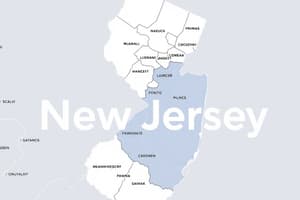Podcast
Questions and Answers
What is a characteristic of small communities in regards to population?
What is a characteristic of small communities in regards to population?
Smaller population - fewer inhabitants
What is a characteristic of large communities regarding population?
What is a characteristic of large communities regarding population?
Larger population
What is a characteristic of small communities regarding economy?
What is a characteristic of small communities regarding economy?
Limited economy
What is a characteristic of small communities regarding public services?
What is a characteristic of small communities regarding public services?
What is a characteristic of small communities regarding community?
What is a characteristic of small communities regarding community?
Flashcards
Small municipalities: Population
Small municipalities: Population
Smaller population size allows for quicker political decisions and a focus on local needs.
Small municipalities: Economy
Small municipalities: Economy
Challenging to finance large projects, potentially relying on state contributions.
Small municipalities: Public services
Small municipalities: Public services
Residents may need to travel further to access certain services.
Small municipalities: Community
Small municipalities: Community
Signup and view all the flashcards
Large municipalities: Population
Large municipalities: Population
Signup and view all the flashcards
Large municipalities: Economy
Large municipalities: Economy
Signup and view all the flashcards
Large municipalities: Public services
Large municipalities: Public services
Signup and view all the flashcards
Large municipalities: Community
Large municipalities: Community
Signup and view all the flashcards
Study Notes
- Differences between small and large municipalities
Small Municipalities
- Smaller population, fewer residents, political decisions can be made faster, focus more on local needs
- Limited economy, more difficult to finance major projects or offer a wide range of services, can also depend on state contributions
- Fewer public services: Residents may need to travel further to access certain services, such as a medical center
- Strong community: Close cooperation between residents and local authorities
Large Municipalities
- Larger population: Can face more complex needs and challenges
- Decisions can take longer to make and have more interests to balance
- Greater economic resources: Can offer a wider range of services, such as sports and social services
- More developed network of public services with better access to schools, hospitals, public transport etc.
- Difficult to create community: Because the population is more dispersed, you do not get the same sense of community
Studying That Suits You
Use AI to generate personalized quizzes and flashcards to suit your learning preferences.




